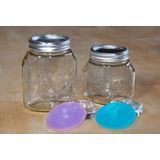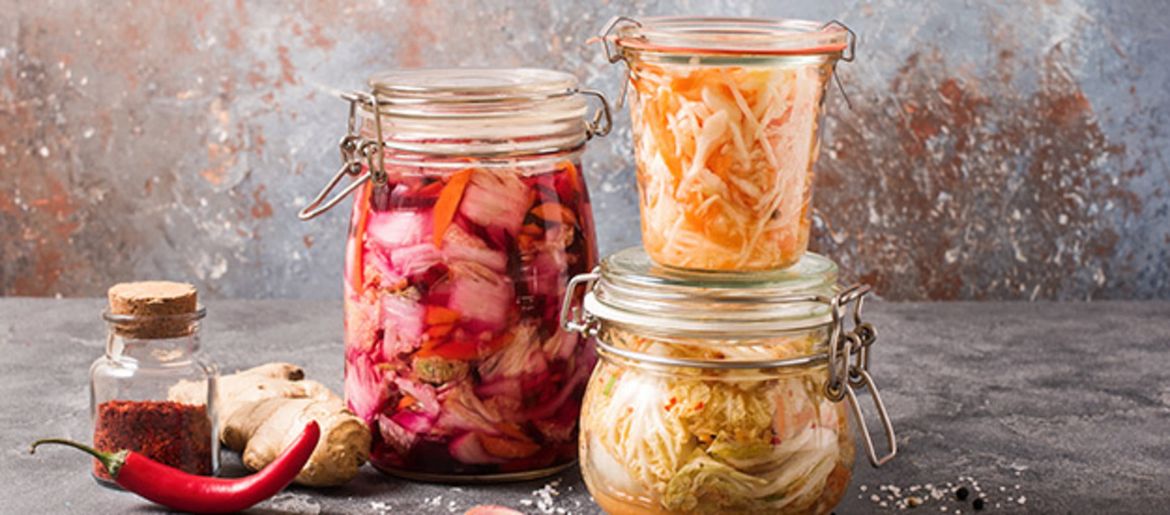Fermentation at Home
Fermented foods are good for health and wellbeing. Here's how you can make them at home.
What is fermentation?
Since ancient times, fermentation has been used as a way to preserve food without heating or adding preservatives and is found in cultures around the world. For example, you can pickle or salt vegetables in brine. Naturally present lactic acid bacteria then get to work, ensuring longer shelf life and also add a characteristic fine, sour taste. These bacteria are also beneficial for the intestines.
Vegetables are perfect if you want to use this method of preserving at home.
Why is fermented food so healthy?
Fermented foods are living foods. They contain enzymes and active lactic acid bacteria that ensure a healthy, balanced intestinal flora by ensuring that harmful bacteria, viruses, fungi and chronic diseases are kept at bay. And because a large part of our immune system is in the intestines, we tend to stay healthier if we consume fermented foods.
Fermenting also opens the cell tissue of vegetables, making them easier to digest - fermented vegetables are therefore an excellent alternative for those who cannot easily digest raw vegetables. They contain many vitamins and phytochemicals that have an antioxidant and immune-stimulating effect. Additionally, because they are metabolised in an alkaline way, it helps to balance the body's acid-base balance.
Make your own fermented foods easily and sustainably
If you want to try making fermented foods yourself, we have good news: it is quick and easy to do and offers a wide range of options to suit every taste. For example, almost any vegetable can be fermented and thus preserved for up to six months - great news for those who have more vegetables in the garden than they can eat. Fermenting without heat also means that many important nutrients, vitamins and minerals are retained.
Types of fermentation
There are basically two methods of fermentation: dry and wet fermentation. Dry fermentation works with salt. Take 2% salt of the total vegetable weight (i.e. 20 g salt for 1 kg vegetables), sprinkle it directly on the vegetables, mix everything well and then mash or knead it until the juices are released.
Wet fermentation involves pouring brine over vegetables. Depending on your taste and the type of vegetable, you add between 20 and 40 g of salt per litre of water to create the brine.
Important: with both methods of fermentation, the vegetables must always be completely covered with liquid before fermentation can start. In addition to the salt and the right temperature, the absence of air is the most important factor for success. It is also important to work cleanly (but not sterile).
Why salt?
Salt removes water from the vegetables and produces the desired brine that should submerge everything. In addition, salt creates the perfect environment for lactic acid bacteria (LAB) to multiply. LAB preserve the fermented vegetables and prevent other, undesirable microorganisms from settling.
It is important to use high-quality, unrefined sea salt without iodine or anti-caking agents and to avoid using chlorinated water. All of these factors could interfere with the fermentation process.
Temperature and time
The fermentation process begins practically immediately. After a day or two bubbles and foam start to form, showing that the fermentation process is successful. Leave it in a dark room for five to seven days at a temperature between 20 and 24°C. Then you can taste to see if the desired degree of acidity has been reached. If so, you can enjoy the vegetables right away or store them in a cool and dark place. This slows down the fermentation and this taste is more or less retained. Otherwise, leave it to stand in the warm room for a few more days until it reaches the desired level of acidity. There is no perfect time when the fermented vegetables are "ready". It's just a matter of personal preference.
Basic fermentation equipment
There are many different ways to ferment. The Complete Fermentation Kit by Khoysan is an easy way to do it. In this system, a special fermentation attachment with a one-way valve ensures that gases released during fermentation can escape but that no air or oxygen can enter. This prevents mould from forming. The attachment is made of food-grade silicone and is free from BPA and phthalates or other plasticisers. Glass weights and a vegetable tamper made of wood are also included.
In addition to the attachment, you will need fermentation glass jars with two-part screw caps, the openings of which are matched to the diameter of the fermentation attachments.
So - what are you waiting for? Start fermenting your own foods at home now and enjoy healthy, nutritious food on a regular basis.
Related products
-
 5.0 (2)
5.0 (2)Khoysan Meersalz Complete Set of Fermenting Glasses, 1 Litre
- With a 2-part screw cap
- Available in two different sizes
- Glass weight + silicone airlock
€ 25,49Delivery by April 16
-
 4.5 (2)
4.5 (2)Khoysan Meersalz Complete Fermentation Kit
- Several practical fermentation accessories in one set
- BPA and phthalate-free
- A sustainable method of preservation
€ 74,49Delivery by April 16
Magazine Articles:
Discover Piccantino :
-
Austria: Free standard delivery from € 49,90
-
Free
returns -
24-hour shipping
More than 11.500 products

